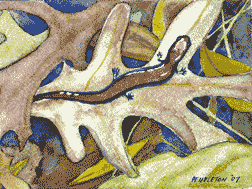|
|
 |
||||||||||
|
|||||||||||
|
|||||||||||
Red-Backed SalamanderInvisible beneath your feet, they dominate the forestIf you take a walk through your favorite patch of woods with an eye out for wildlife, you might see dozens of birds. You are also likely to find squirrels, possibly a herd of deer and occasionally other mammals. More is out there, but much of it stays hidden. Take, for example, Plethodon cinereus, the red-backed salamander. There are likely to be more individual red-backed salamanders in those woods than the total number of all the mammals and birds. What’s more, the total biomass of the salamanders would probably outweigh the birds and be roughly equal to the weight of all of the small mammals. You have been walking all over them without, one hopes, stepping on any. The salamanders are staying safe beneath logs and rocks or in the top layer of soil. This top layer, called humus, is a loosely packed amalgam of rotting leaves and sticks. Lungless salamanders, such as the red-backed, breathe through their skin. The skin must stay moist because if it dries out, they’ll die. That is why they keep mainly underground but close to the surface where it stays damp — and where they seek their prey. Red backed salamanders are a top predator of what is
called the detritus food chain. In other words, they eat a lot of insects, like beetles and worms that feed from and break down the fallen leaves and dead wood. If you are what you eat, then you could say that salamanders are the forest. Moist conditions support salamanders’ survival, but dry periods make them easier to find. When the ground is damp, the salamanders are able to spread out to find a little, shall we call it, breathing space. When there is no rain, the dry topsoil becomes inhospitable to salamanders. So they seek refuge under logs and other places where it stays damp. That is where you might see them. Researchers who study salamanders have a simple technique to find them; it can also be used to locate red-backed salamanders in the backyard. Place a piece of scrap lumber flat on the ground, preferably near trees or bushes. Periodically check underneath, and you might find one. The salamanders should not be kept as pets, but if you have a camera ready, you might be able to capture a photo. |
|||||||||||
|
|||||||||||
|
|
|||||||||||
|
© COPYRIGHT 2007 by New Bay Enterprises, Inc. All rights reserved. |
|||||||||||

